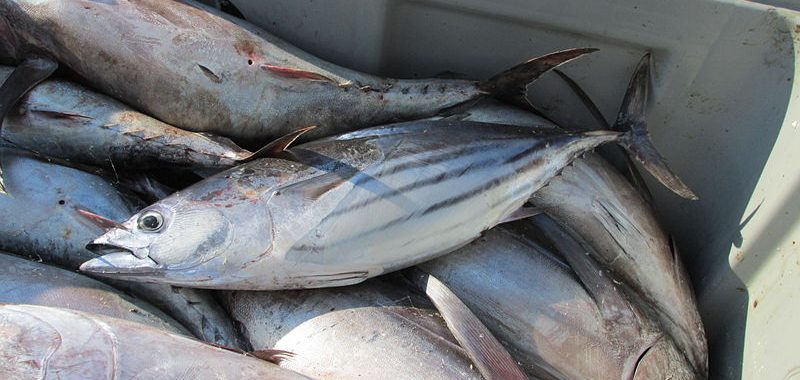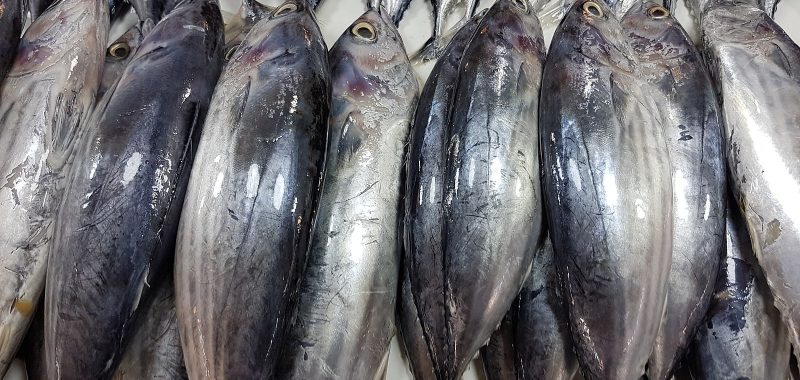Priority Species: Skipjack tuna
Scientific name: Katsuwonus pelamis
Skipjack are one of the most abundant of the commercial tuna species, and global stocks are healthy. The sustainability concerns are due to the impact of the fishing methods for skipjack on other more vulnerable species. However, juvenile bigeye tuna and yellowfin tuna are often caught alongside skipjack, both of which are depleted in many oceans. This presents issues when it comes to sustainability, as fishing for skipjack could have consequences on these more vulnerable species.
The majority of skipjack tuna are harvested using floating objects called Fish Aggregating Devices (FADs). These devices are either placed in the water by fishing boats or are found floating objects such as tree trunks or barrels. The devices can either be anchored or left free floating, but marked with a GPS device for tracking. FADs attract large schools of skipjack tuna allowing boats to efficiently encircle the schools with purse seine nets. Although FADs are highly effective at attracting large schools of skipjack, they are also effective at attracting species more vulnerable to overfishing such as sharks and rays, sea turtles, and marine mammals that also get scooped up in the nets dead or injured. Skipjack tuna purse seine fisheries also catch juvenile yellowfin and bigeye tuna, both of which have less healthy populations and lack robust management plans.
The use of FADs is the primary reason for large declines in the Atlantic bigeye tuna stocks, which are overfished and continuing to be subject to overfishing. When FADs are used in skipjack fisheries, juvenile bigeye that also aggregate around the FADs are often caught as bycatch. This means that fewer bigeye survive to reproductive age, threatening the stock’s ability to rebuild. Yellow fin tuna, caught in association with skipjack purse seine, are also declining and lack management plans with robust Harvest Control Rules (HCRs).
A portion of the largest purse seine skipjack and yellowfin tuna fishery in the Pacific Ocean has been certified by the Marine Stewardship Council (MSC) since 2011. Approximately half of the fishery’s total catch is done as ‘free school sets’ (not using FAD’s), passing MSC certification. The rest relies on FAD’s, which result in high levels of bycatch. This artificial split of the fishery into certified and non-sustainable gear has been controversial. Additionally, observer reports from the Western Central Pacific Fisheries Commission, the international body that regulates the fishery, show that vessels active in the MSC certified fishery are also involved in shark finning during the same fishing trips in which MSC certified skipjack and yellowfin are caught, despite the WCPFC prohibiting this practice since 2011. This is ultimately misleading consumers who buy eco-certified skipjack tuna.
Although skipjack are considered fairly resilient and are not currently categorized as “overfished”, increases in exploitation rates using FADs and other highly efficient harvesting methods could cause skipjack to fall into a more vulnerable state if not managed appropriately.
Population: A precautionary approach to management and continued implementation of harvest control rules are required to maintain healthy skipjack stocks.
Bycatch: Bycatch remains an issue in fisheries that use FADs, which have been found to have significantly higher bycatch rates than fisheries that don’t use these aggregating devices such as free school purse seines and pole and line fisheries. Entanglement of non-target species is also a problem in fisheries that use drifting FADs. Efforts should primarily focus on reducing the use of FADs to eliminate bycatch and entanglement associated with these fisheries. Shifting catch methods to pole and line catch – a lower impact gear – is a key solution to this problem. Secondarily, improvement of FAD management for any remaining FADs such as promoting the use of non-entangling FADs which help to reduce the impact FAD-associated fisheries, can a positive impact on non-target species.
Habitat: N/A
Gear: The best option for sourcing skipjack tuna is from pole and line fisheries as these have low levels of bycatch and are generally limited to sustainable exploitation rates.
When skipjack sourced from pole and line fisheries is not available, FAD-free skipjack caught via free school purse seine is the better option with regard to sustainability. Fishing free swimming schools of skipjack helps reduce bycatch of juvenile tuna species, like the vulnerable bigeye and yellowfin.
Continued improvements to the management of FAD fisheries are necessary before products sourced from these fisheries should be considered sustainable.
Monitoring: Observer coverage for skipjack fisheries remains relatively low, resulting in limited information available with regard to bycatch. Leading organizations working at Regional Fisheries Management Organizations to improve tuna management, are calling for all industrial purse seine and lonline tuna vessels to implement 100% observer coverage to ensure compliance with management and conservation measures and improve data collection on all species caught.
Markets: Efforts should focus on promoting pole and line fisheries as the most sustainable options for sourcing skipjack. Promoting these more selective fisheries can help to support the growth of the fisheries by increasing market demand for their products. Fisheries gaining MSC certification which use fishing methods such as FADs should be closely monitored for sustainability and compliance against the certification standard.
Common/Market Name
Skipjack tuna
Distribution
Skipjack are a highly migratory species of tuna found throughout the Atlantic, Indian and Pacific Oceans between 45N and 40S.
Harvest Method
Gear types: Purse seine, pole and line (bait boat)
Management Agency
The Western and Central Pacific Fisheries Commission (WCPFC), Indian Ocean Tuna Commission (IOTC), Inter-American Tropical Tuna Commission (IATTC), International Commission for the Conservation of Atlantic Tunas (ICCAT).
Market Distribution
Globally, skipjack is the most widely caught commercial tuna species with the majority of the catch used for canning and other processed tuna products. Indonesia, Korea, Japan, Spain, Papua New Guinea, and USA among the top fishing countries for skipjack while Thailand, Spain, and Ecuador are the top canning countries. The product is distributed globally, including to the Canadian market.




